Want to learn how to make homemade mayonnaise? This recipe is made with a few simple ingredients and the traditional technique for a delicious homemade condiment. With step by step photos and lots of tips!
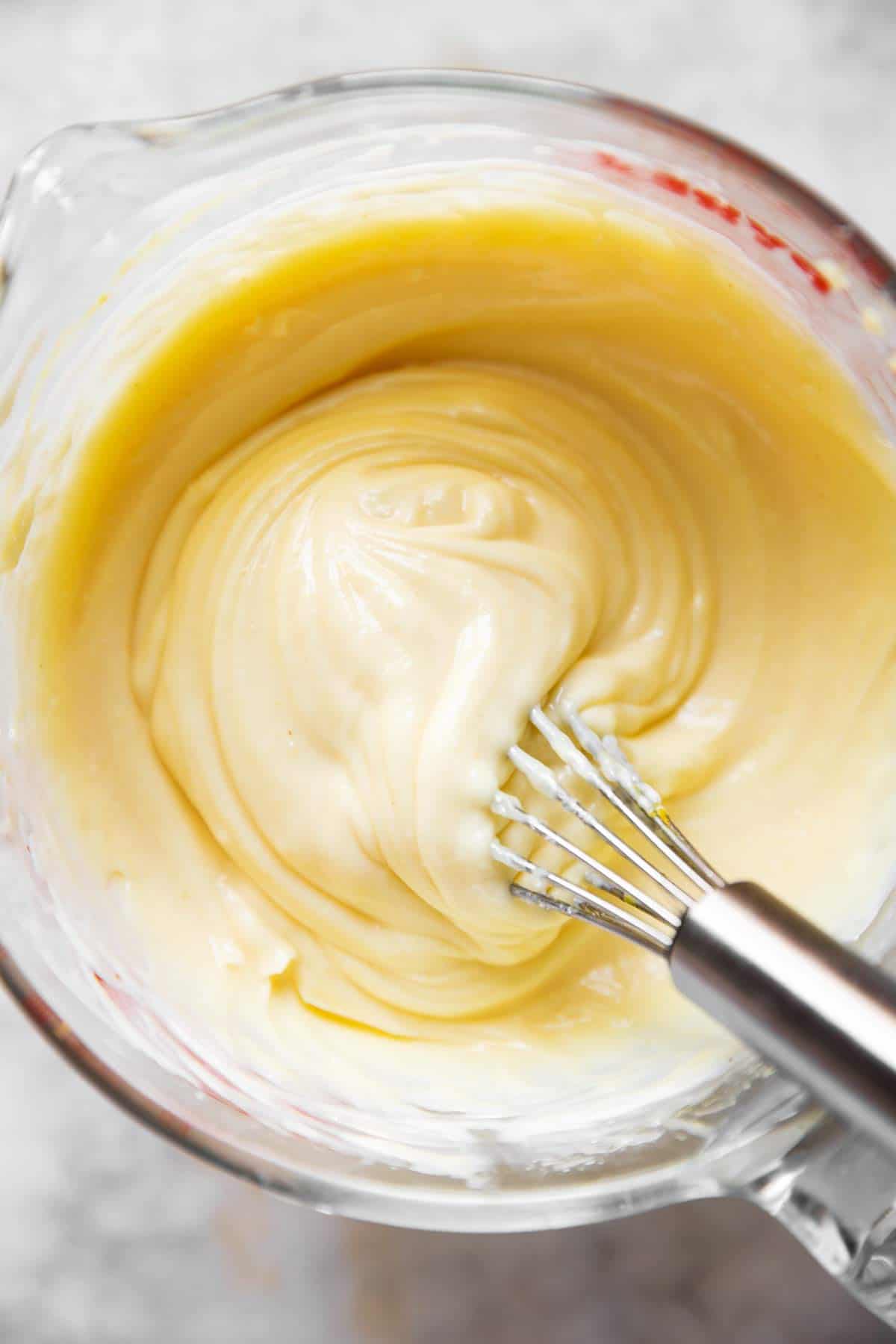
I have to confess, I’m not the biggest fan of store-bought mayonnaise dishes. But a batch of homemade one? I absolutely love it.
Making mayonnaise may be simple, but it’s not hands-off work. You do need to do a lot of whisking, and you need to follow the technique closely. But it’s very rewarding to eat homemade mayo, so it’s worth it to me ?
Jump to:
Ingredients you’ll need
Here is a visual overview of the ingredients in the recipe. Scroll down to the printable recipe card at the bottom of this post for quantities!
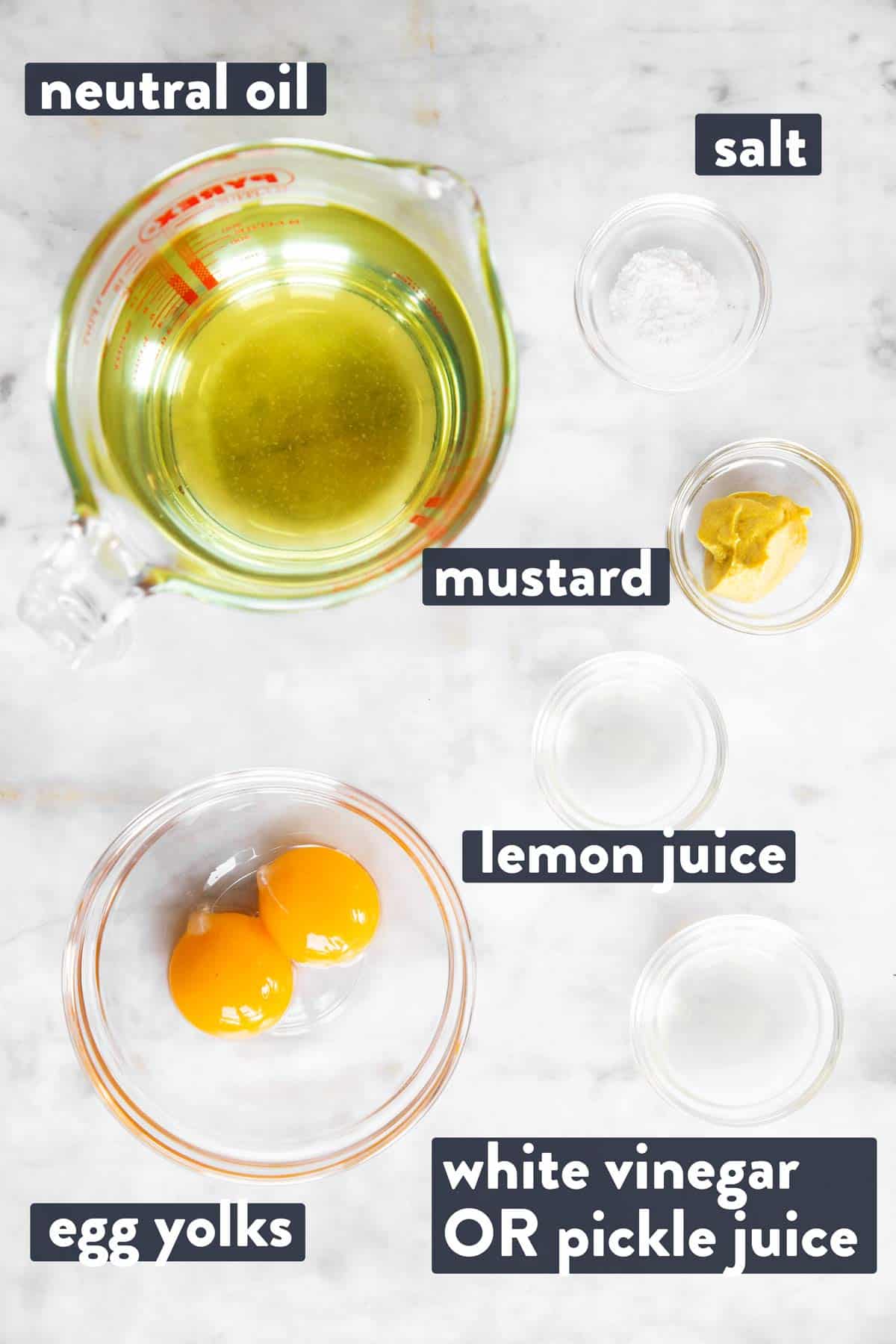
Ingredient notes
- Egg yolks: The USDA recommends using in-shell pasteurized egg yolks to safely make homemade mayonnaise. I personally choose to use correctly refrigerated, organic grad AA raw egg yolks. Use what you are comfortable with, but I would only recommend using the freshest, highest-quality eggs for this recipe.
- Oil: You must use a neutral vegetable oil to make mayonnaise! Otherwise, it will taste off. Safflower, canola or grapeseed all work great. I’ve also heard people like peanut oil or avocado oil, but I never tried it myself. I know many recipes call for olive oil, but I never use it for mayo. If you absolutely want to use olive oil, please use a light one that doesn’t have a strong taste.
- Mustard: The mustard helps a great deal with the emulsification, so please do not skip it. If you can’t have mustard, leave it out but know that your mayo may be a little more difficult to whisk.
- Lemon juice/salt/vinegar: These ingredients are key to a delicious mayonnaise. You need the acid to offset the richness, and you need the salt to make the mayo tasty. Season to taste once all of the oil has been added, just be mindful of the amount of vinegar you add – if you add too much, your mayonnaise can split (I have added up to 6 tablespoons without any issues).
Chef’s tip: Secret ingredient!
My husband is a classically trained chef with years of experience in high-end professional hotel and restaurant kitchens. He told me he was taught to add pickle juice instead of vinegar to mayonnaise – and truly, it is my favorite ingredient to add!
Make sure to use tart/brine-y pickle juice, and not one from more sweet pickles. I always buy French-style Cornichon pickles from Maille and they have the best liquid for mayonnaise!
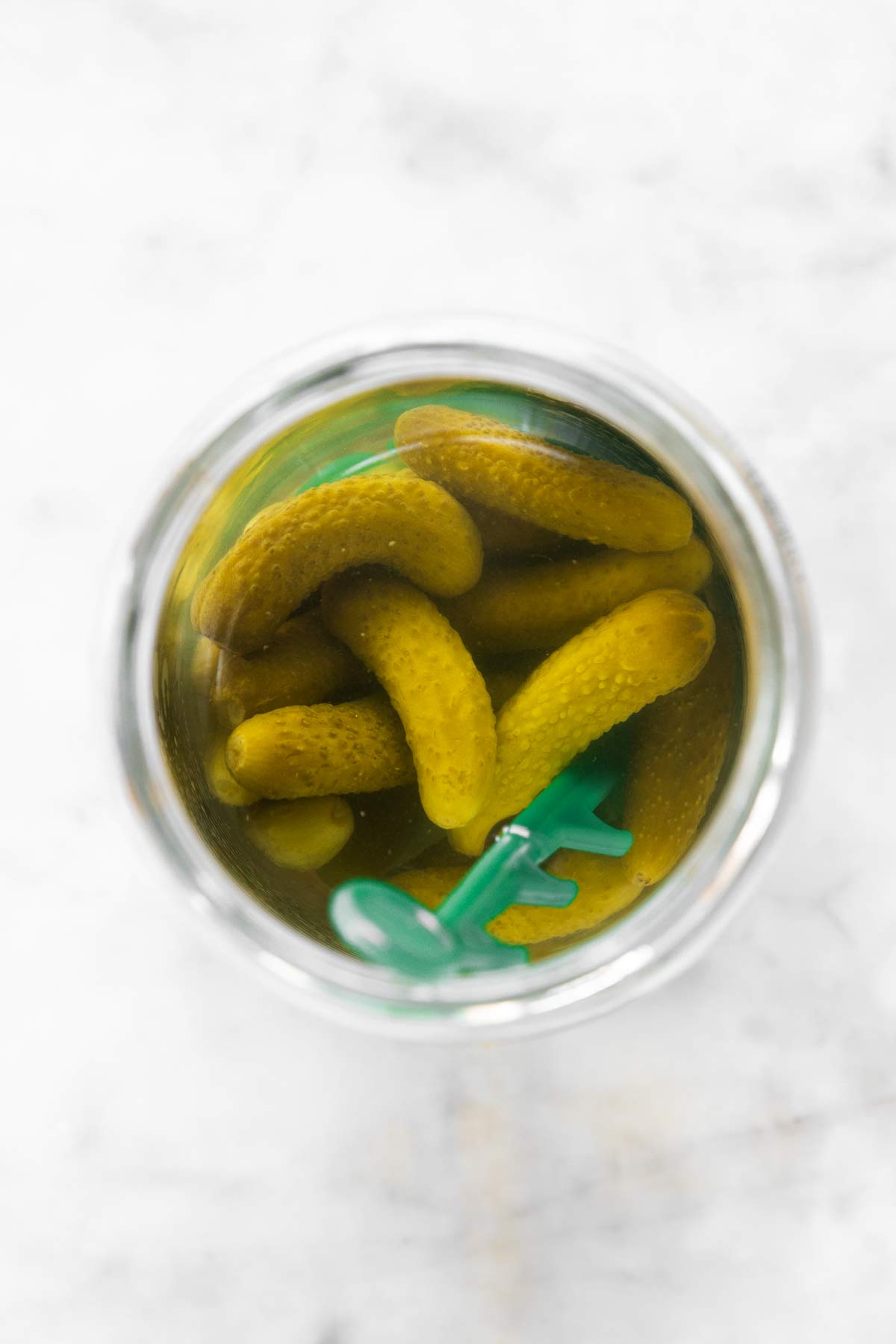
How to make Mayonnaise
1. Place a damp cloth on your work surface, then place your egg yolks in a large measuring jug or wide bowl (mine holds 4 cups) and sit it on the damp cloth.
The cloth will help to keep your bowl in place when you’re whisking the mayonnaise while pouring in the oil, and it will make it more comfortable to rest the bowl while while whisking the yolks initially.
add damp cloth on work surface place bowl on top
2. Whisk your egg yolks for 2-3 minutes, until pale in color and frothy with increased volume. Add the mustard and whisk for 1-2 more minutes.
Make sure to scrape the sides of your bowl with a rubber spatula before starting to add the oil – you want all of the egg yolk to emulsify with the oil.
egg yolks before whisking egg yolks after whisking with mustard whisked in scrape sides before adding the oil
3. Start slowly pouring in the oil while constantly whisking vigorously. I do about 1 tablespoon at a time, quickly pause to fully whisk in the oil, then slowly pour in another tablespoon, all while constantly whisking.
Stop once you have added about half of the oil.
slowly whisk in oil mixture will appear split when more oil is added keep whisking to bring it together stop once half the oil is added
4. Whisk in 1 tablespoon vinegar to loosen the mixture (this makes it a little easier to whisk once you add the remaining oil). The vinegar will also lighten the color of your mayonnaise.
before adding vinegar after adding vinegar
5. Slowly pour in the remaining oil while constantly whisking to keep the mixture smooth.
The mayonnaise will be pretty thick at this point, and it will taste pretty rich and bland – don’t freak out, this is normal and will change once we season it.
slowly whisk in remaining oil mayonnaise will be thick
6. Finally, season your mayonnaise with lemon juice, salt and vinegar (or pickle juice!) – you will need to check the taste continuously and keep adding vinegar/pickle juice and salt until your mayo is to your taste.
before adding salt/vinegar after adding salt/vinegar
Keep in mind, the vinegar loosens the mayonnaise and adding too much can cause it to split. I have added up to 6 tablespoons to this recipe without any issue, but just be mindful and whisk it in gradually.
And with that, your mayonnaise is done!
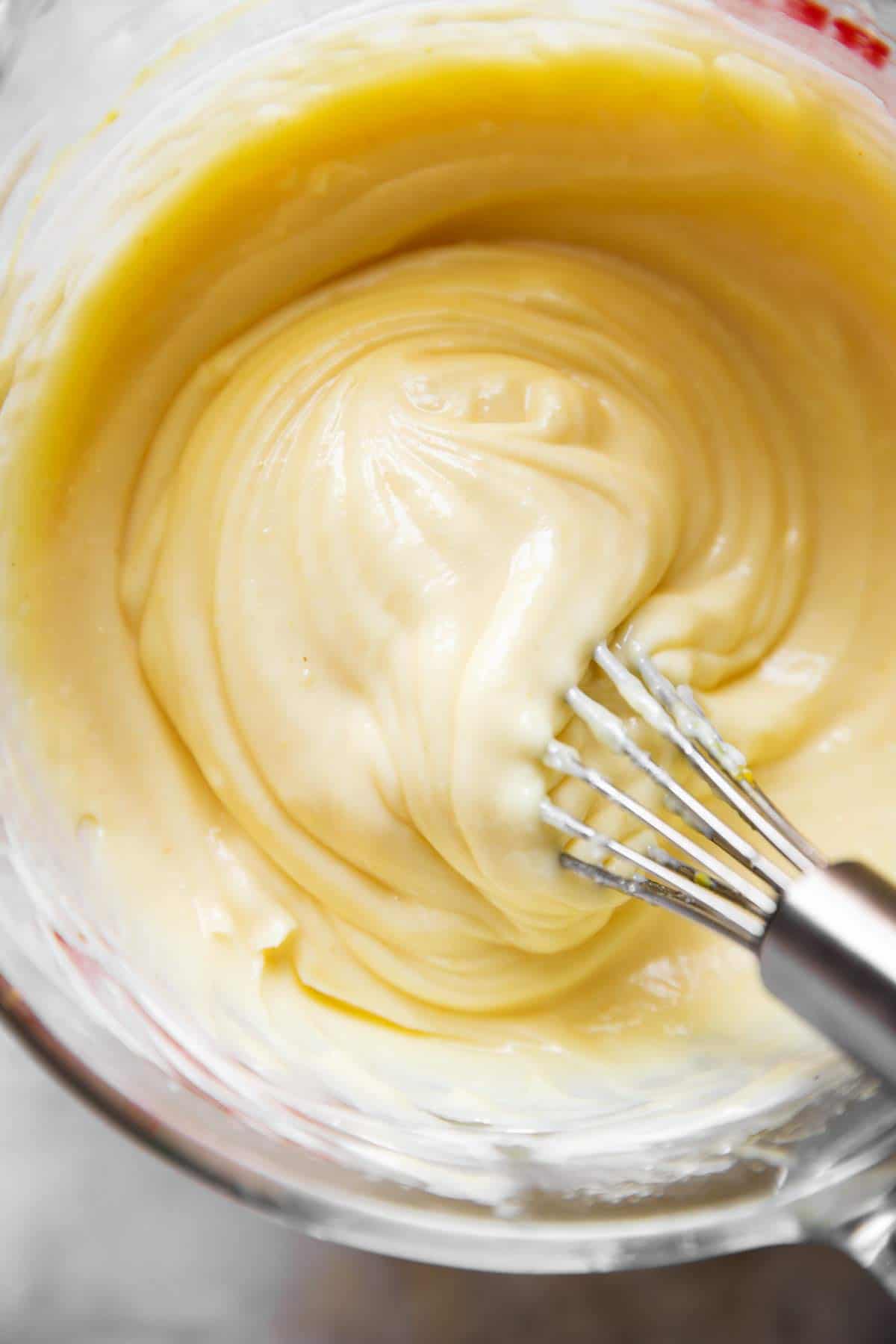
Recipe tips
- Homemade Mayonnaise is simple, but it does take a lot of active work for about 10 minutes. You must keep whisking to incorporate all of the oil, otherwise your mayo will not come together.
- If your mayo tastes bland/oily and seems too thick before you’re seasoning it, don’t worry! That’s normal. The vinegar (or pickle juice) will offset the richness and also give the mayo the right consistency.
- Make sure to salt your mayonnaise enough, else it will be bland. I recommend salting little by little and stirring in your salt with a spoon once you have added your vinegar, in order to avoid overmixing the mayo.
- You can technically make mayonnaise in a food processor or using an immersion blender, but not everyone owns these gadgets, so I decided to share the traditional method using a whisk. The immersion blender method in particular does need some skill and needs to be done very carefully; and I do personally prefer the whisk method. Also, every kind of motorized blender produces more heat than hand whisking, which can affect the quality of the oil and therefore the mayo. And it’s easier to break the emulsion with a blender, too. This recipe really doesn’t take too much time, so I believe for the best result, we don’t need to resort to shortcuts.
- If you use pasteurized egg yolks and are wondering what to do with the pasteurized egg whites you have left over, make some extra-airy Tiramisu!
Mayonnaise FAQs
The egg yolk contains molecules (called lecithin) that stick to both water and oil, which creates an emulsion. This is what causes mayonnaise to thicken.
Yes, you can. The two tricks to making mayonnaise are to add the oil slowly and to whisk quickly; but once all of the oil (and at the end the seasoning) has been incorporated, do not keep whisking. Otherwise, you could break your emulsion.
This is also one of the reasons why I prefer to hand-whisk mayo vs using a blender or food processor – it is much harder to over-beat and therefore break your emulsion when hand whisking.
Don’t worry, you can fix your broken mayo. Either beat another egg yolk, or beat a teaspoon of mustard in a new bowl.
Slowly add your broken mayo, beating it well. Once all of your mayo has been added, it should be re-emulsified.
First of all, use the right oil. Many people swear by light olive oil, but I generally prefer safflower, grapeseed or canola oil for the least oil smell/taste.
Secondly, mayonnaise is mostly oil, so you need to add other ingredients to offset this richness/oiliness. Vinegar (pickle jucie!), mustard and lemon juice not only support the emulsion, but they also make the mayonnaise taste less overwhelmingly oily.
Storage tips
Once you have e made your mayo, store it in a clean jar with a lid in the fridge. It should last for 5-7 days.
Always remove mayo with a clean spoon and immediately refrigerate leftovers again. Do not let your homemade mayonnaise sit out at room temperature for any length of time (I mean, 5 minutes while you’re whipping up a sauce or dressing is fine).
When we use this as a condiment with dinner everyone serves themselves from, I spoon some into a small bowl and keep the rest refrigerated.
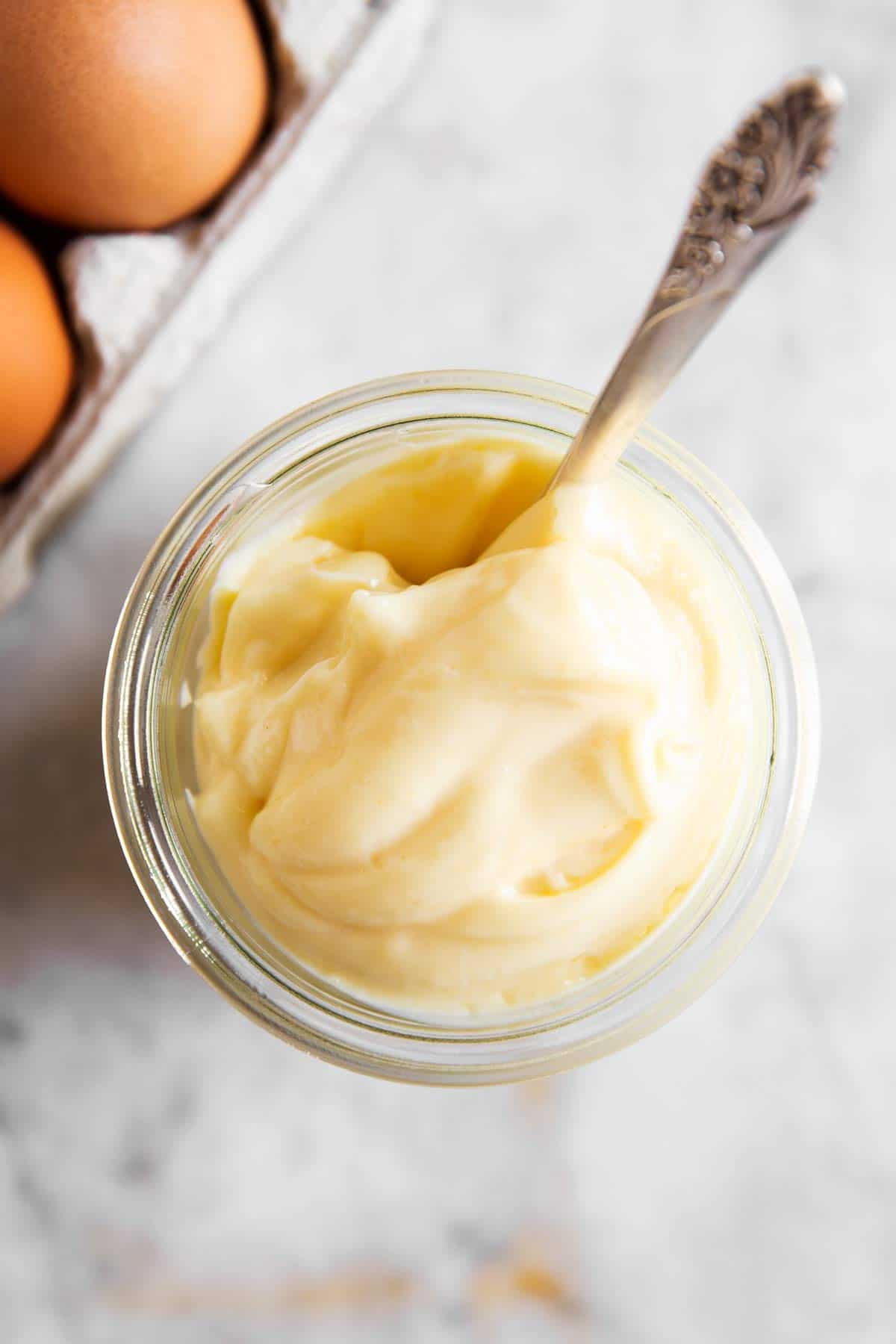
Recipe ideas
There are many ways to use your homemade mayo, apart from using it for vegetable sticks and to slather on basically everything ?
Keep in mind to refrigerate dishes you make with homemade mayonnaise, and to not leave salads made with homemade mayo out on a BBQ buffet or on the counter. They need to go back into the fridge immediately.
- Make a creamy dill potato salad
- Use it in a macaroni salad or coleslaw
- Make extra-delicious deviled eggs
- Use it for chicken salad
- Make homemade sauces, like Chick-Fil-A Sauce or Chipotle Mayo
PS If you try this recipe, please leave a review in the comment section and add a star rating in the recipe card – I appreciate your feedback! Follow along on Pinterest, Facebook or Instagram.
Printable recipe
Homemade Mayonnaise
Recipe details
Ingredients
- 2 high-quality egg yolks pasteurized egg yolks are recommended
- 1 teaspoon Dijon mustard
- 2 cups neutral vegetable oil safflower, canola or grapeseed are my favorite
- 6 tablespoons white wine vinegar OR Cornichon pickle juice for more flavor; or use less to taste
- 1 teaspoon lemon juice or more to taste
- salt to taste
Instructions
- Prep egg yolks: Whisk the egg yolks in a bowl or measuring jug until pale in color, fluffy and increased in volume (about 2-3 minutes of vigorous whisking). Add the mustard and beat for 1-2 more minutes. (Depending on the size of your bowl/measuring jug, you may need to tilt it to whisk this smaller amount properly.)
- Add half of the oil: Start to slowly pour the oil into the eggs while continuously whisking fast. I pause the oil after each tablespoon or so to fully incorporate the oil in the bowl before slowly pouring in more.
- Loosen mixture: Once about half of the oil has been added, stop pouring in more. Whisk in 1 tablespoon of the vinegar to loosen the mixture (it will also turn paler in color).
- Add remaining oil: Once the vinegar has been whisked in, slowly pour in the remaining oil, constantly whisking well.
- Season: Once you have incorporated and emulsified all of the oil, you should have a very thick mayonnaise. Season with lemon juice, more vinegar (or pickle juice) and salt to taste. Keep the mayonnaise refrigerated at all times and use within 5 days.
Notes
Ingredient notes
- Egg yolks: The USDA recommends using in-shell pasteurized egg yolks to safely make homemade mayonnaise. I personally choose to use correctly refrigerated, organic grad AA raw egg yolks. Use what you are comfortable with, but I would only recommend using the freshest, highest-quality eggs for this recipe.
- Oil: You must use a neutral vegetable oil to make mayonnaise! Otherwise, it will taste off. Safflower, canola or grapeseed all work great. I’ve also heard people like peanut oil or avocado oil, but I never tried it myself. I know many recipes call for olive oil, but I never use it for mayo. If you absolutely want to use olive oil, please use a light one that doesn’t have a strong taste.
- Mustard: The mustard helps a great deal with the emulsification, so please do not skip it. If you can’t have mustard, leave it out but know that your mayo may be a little more difficult to whisk.
- Lemon juice/salt/vinegar: These ingredients are key to a delicious mayonnaise. You need the acid to offset the richness, and you need the salt to make the mayo tasty. Season to taste once all of the oil has been added, just be mindful of the amount of vinegar you add – if you add too much, your mayonnaise can split (I have added up to 6 tablespoons without any issues).
Recipe tips
- Homemade Mayonnaise is simple, but it does take a lot of active work for about 10 minutes. You must keep whisking to incorporate all of the oil, otherwise your mayo will not come together.
- If your mayo tastes bland/oily and seems too thick before you’re seasoning it, don’t worry! That’s normal. The vinegar (or pickle juice) will offset the richness and also give the mayo the right consistency.
- Make sure to salt your mayonnaise enough, else it will be bland. I recommend salting little by little and stirring in your salt with a spoon once you have added your vinegar, in order to avoid overmixing the mayo.
- You can technically make mayonnaise in a food processor or using an immersion blender, but not everyone owns these gadgets, so I decided to share the traditional method using a whisk. The immersion blender method in particular does need some skill and needs to be done very carefully; and I do personally prefer the whisk method. Also, every kind of motorized blender produces more heat than hand whisking, which can affect the quality of the oil and therefore the mayo. And it’s easier to break the emulsion with a blender, too. This recipe really doesn’t take too much time, so I believe for the best result, we don’t need to resort to shortcuts.
- If you use pasteurized egg yolks and are wondering what to do with the pasteurized egg whites you have left over, make some extra-airy Tiramisu!



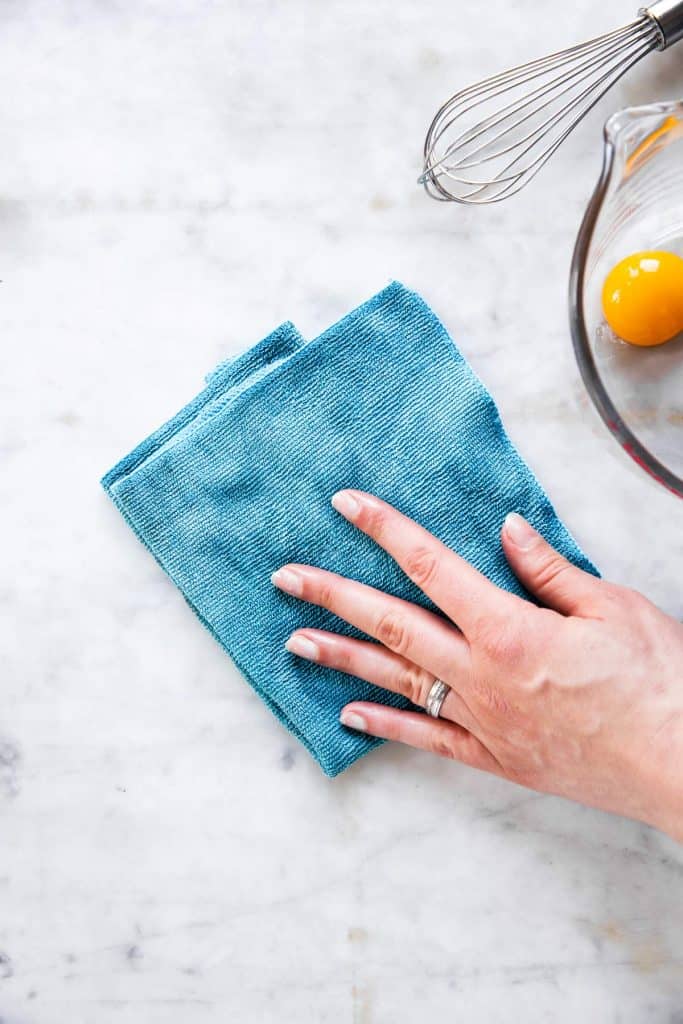
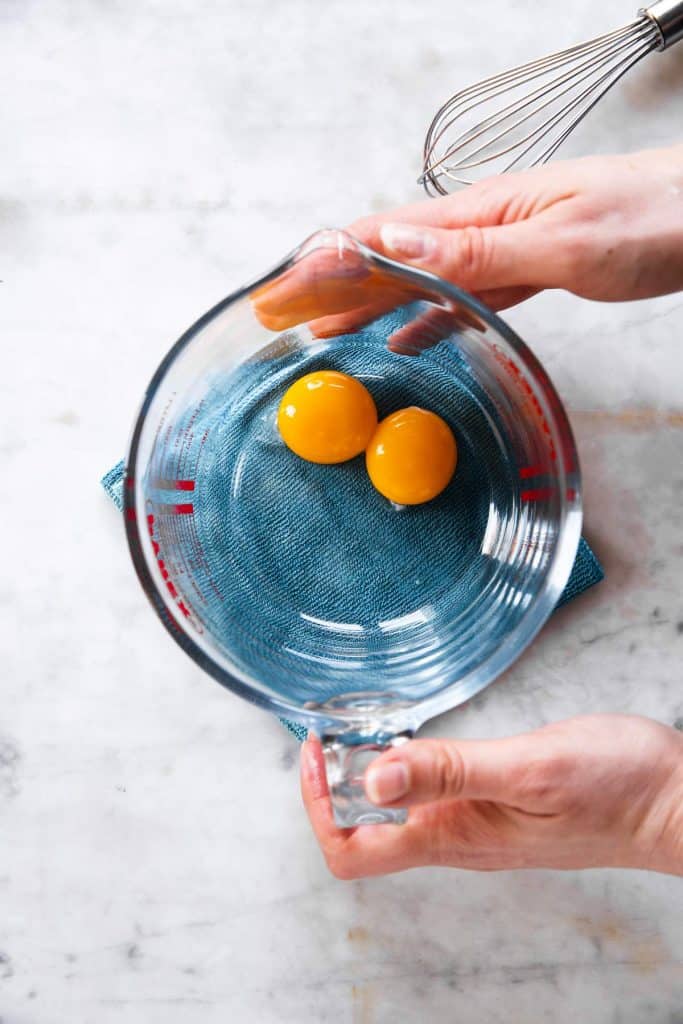
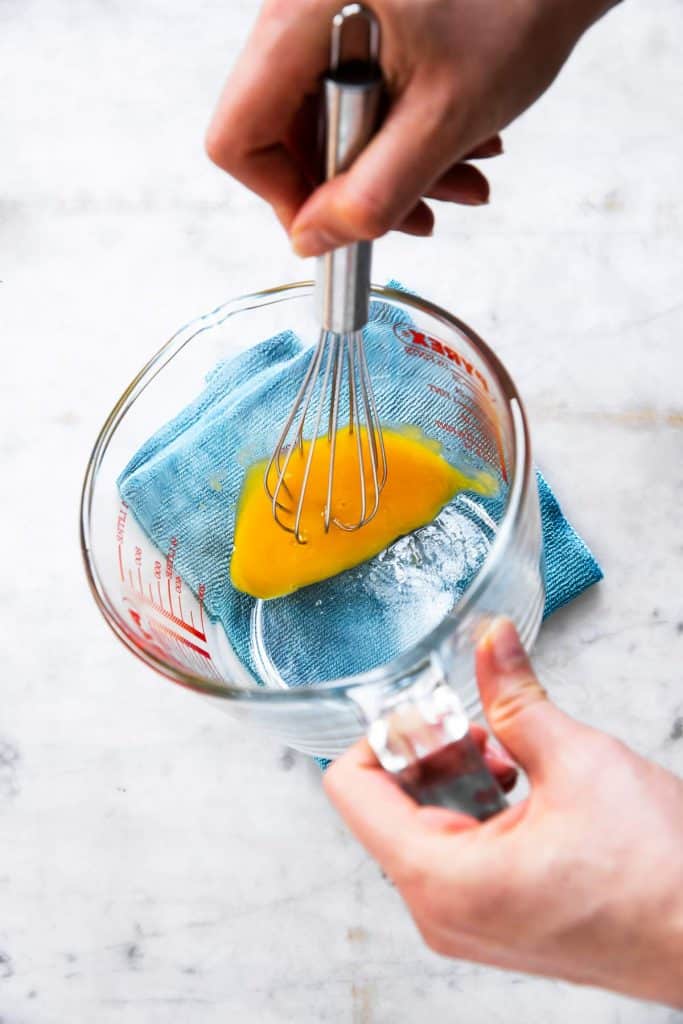
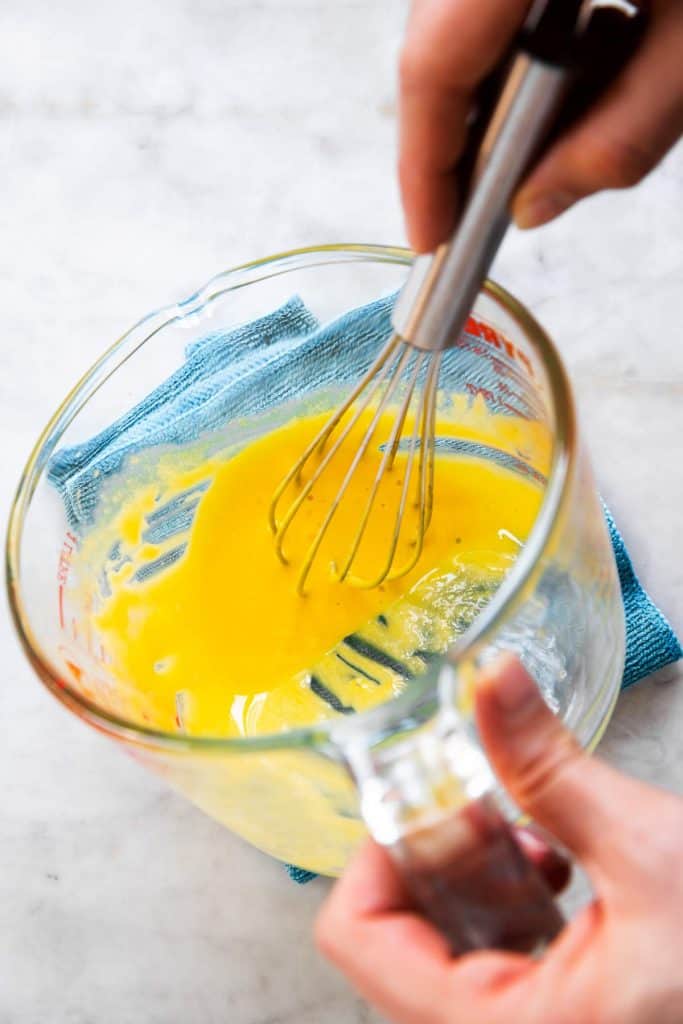
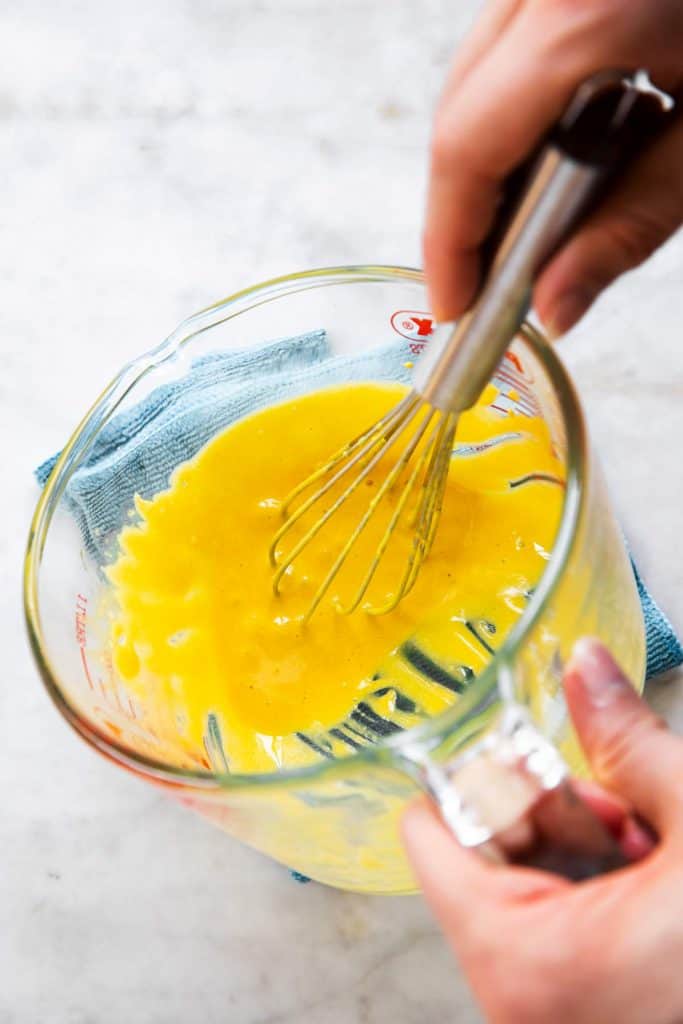
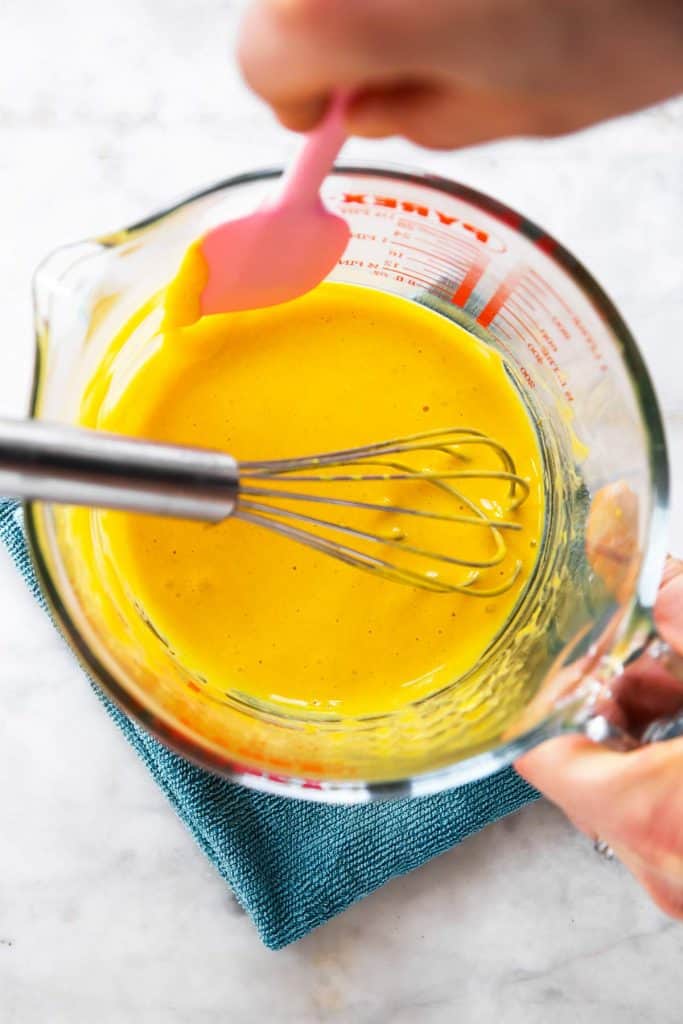
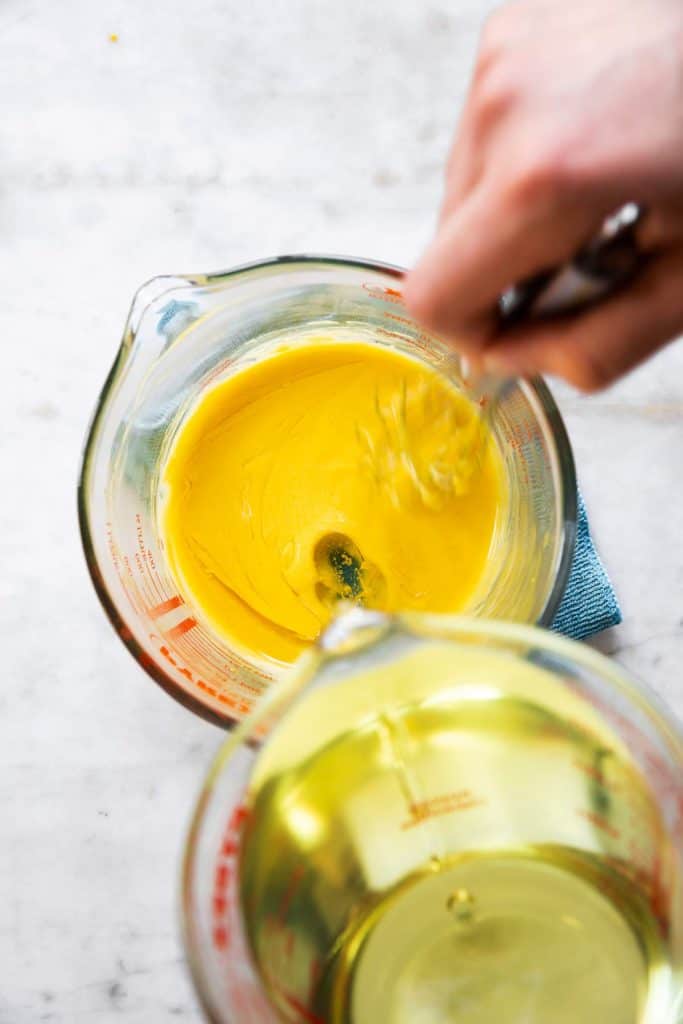
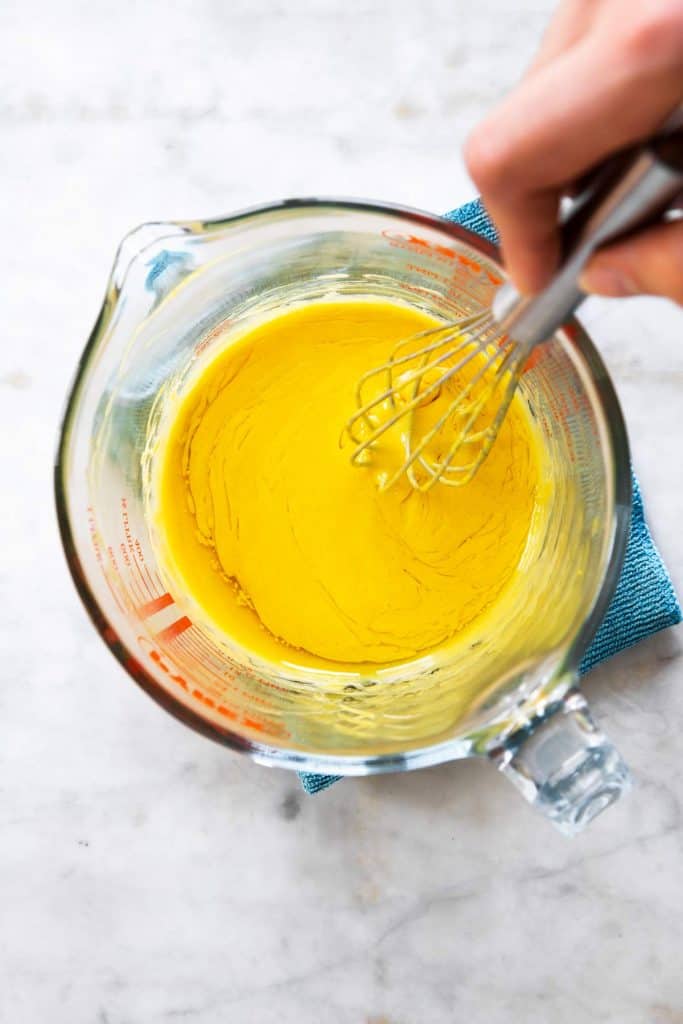
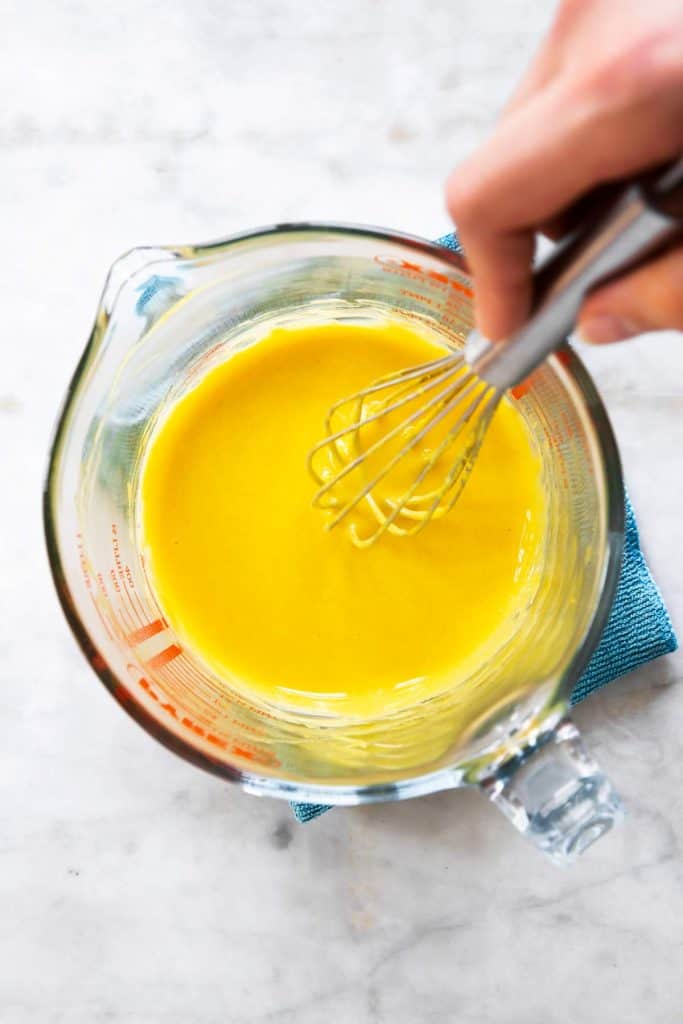
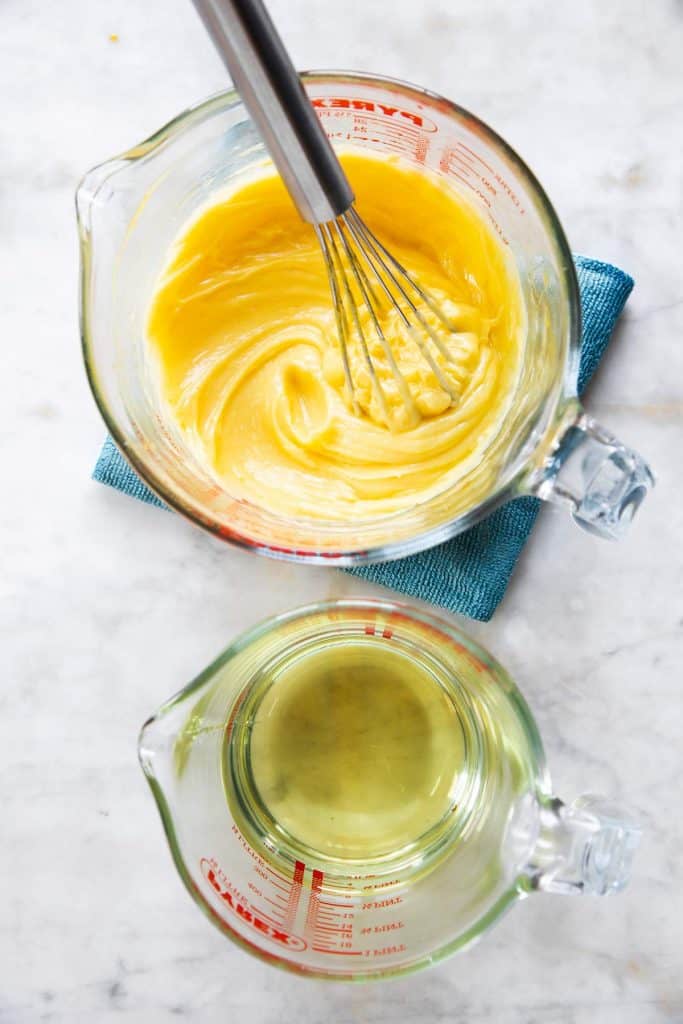
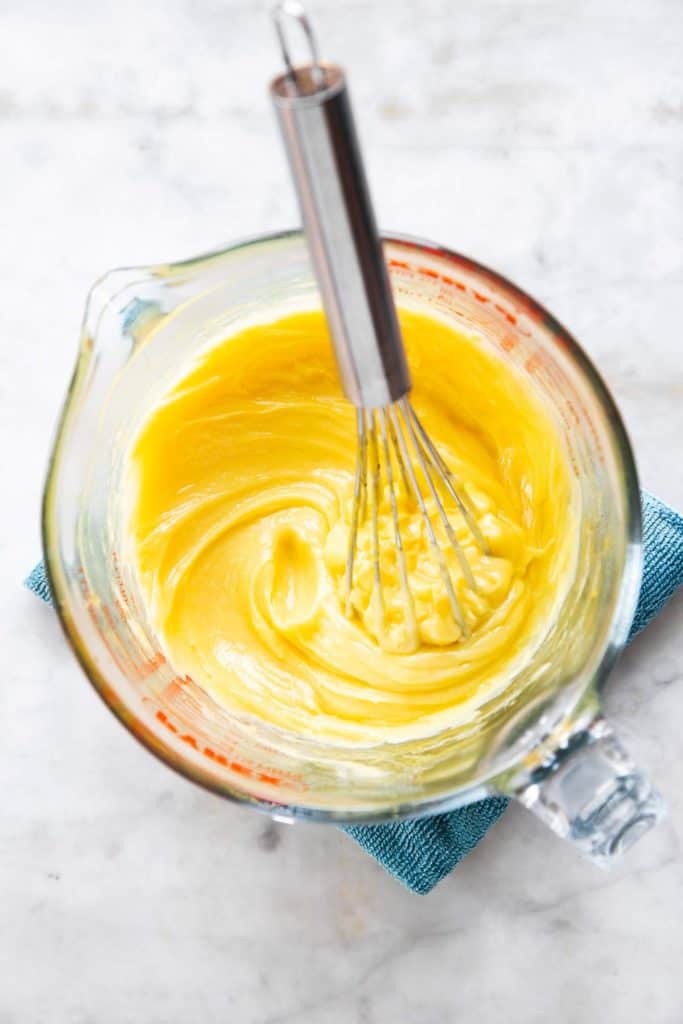
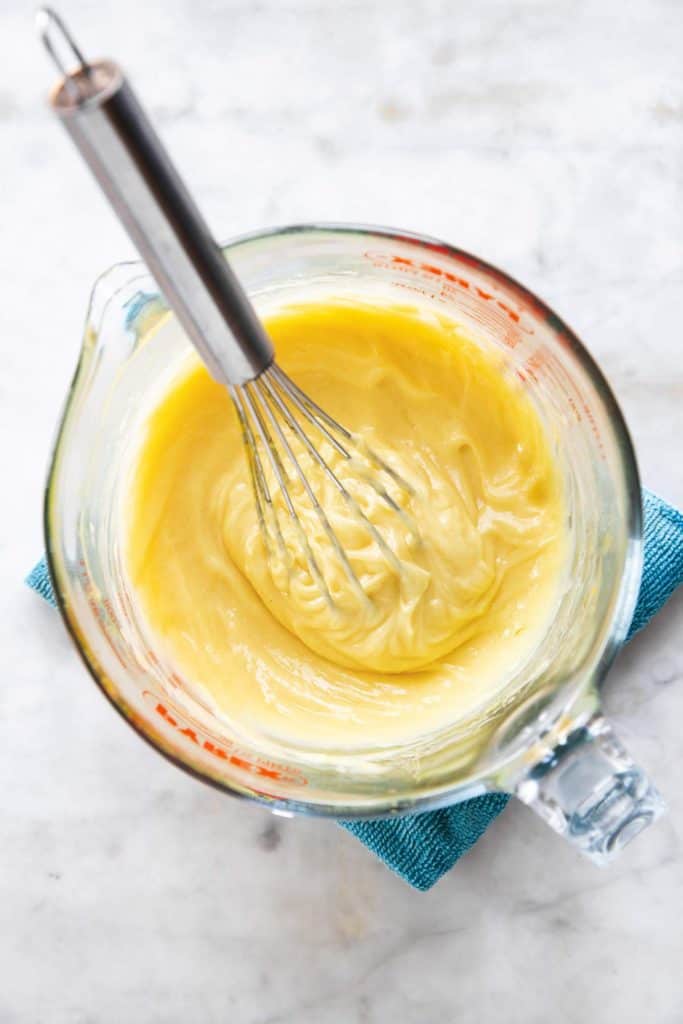
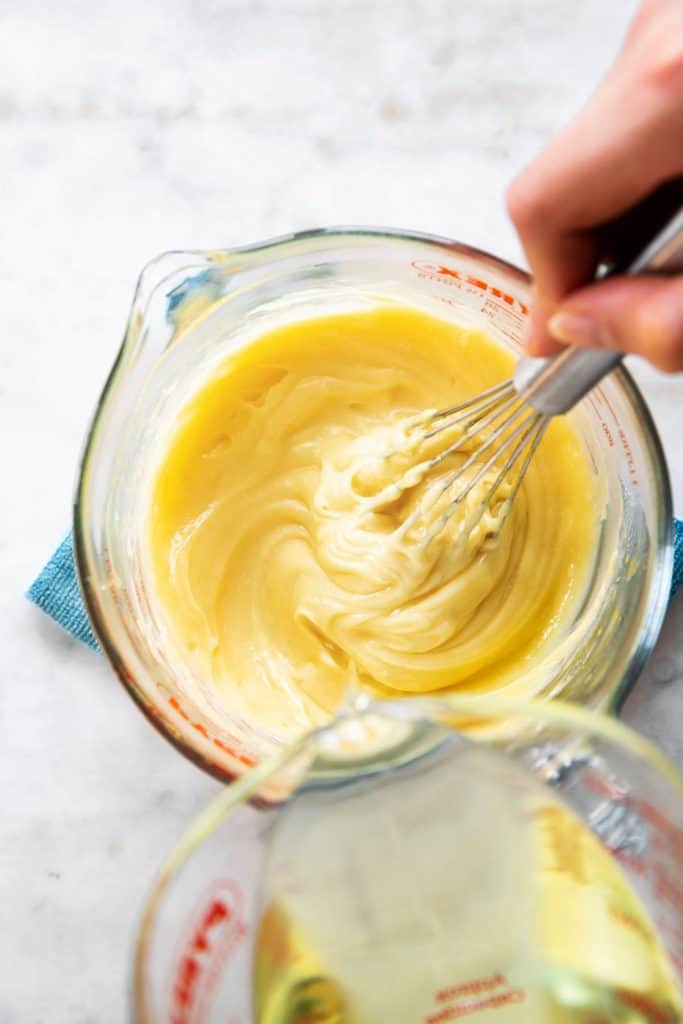
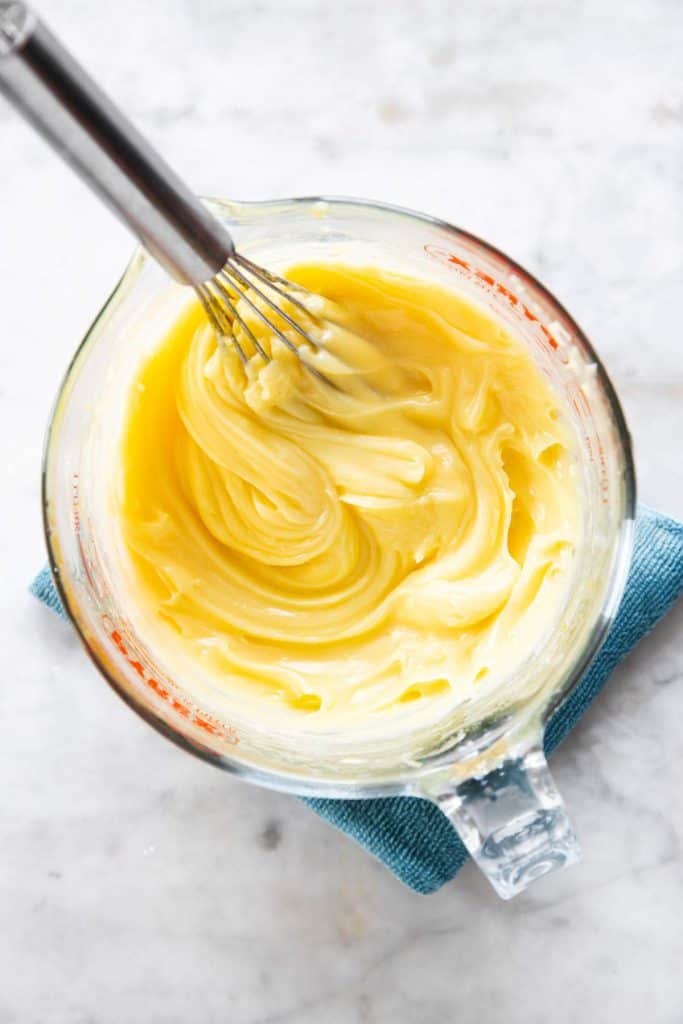
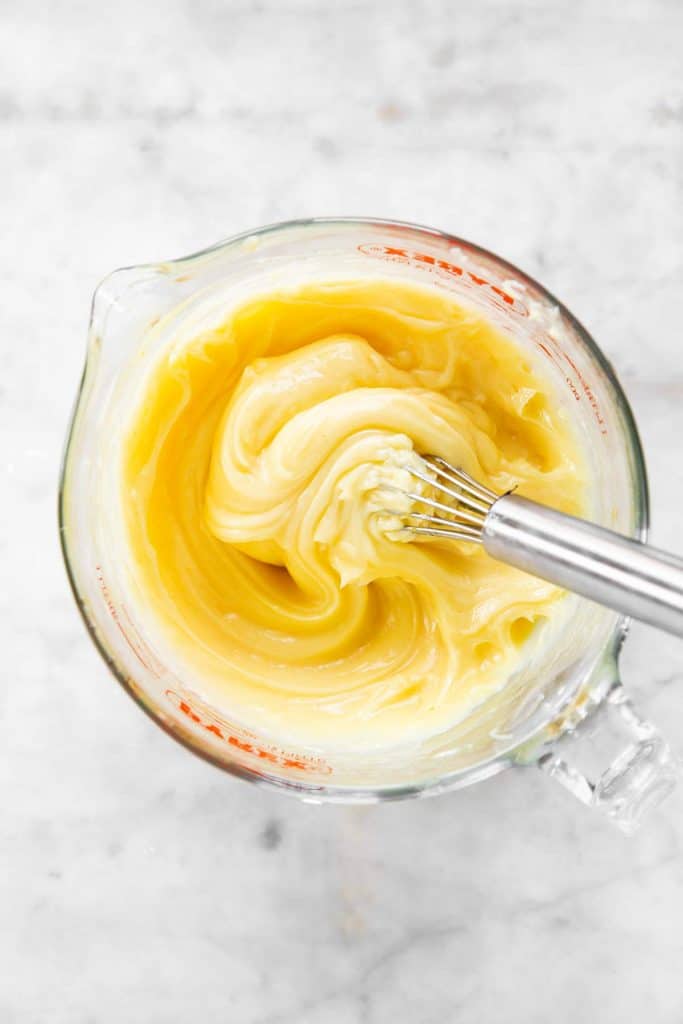
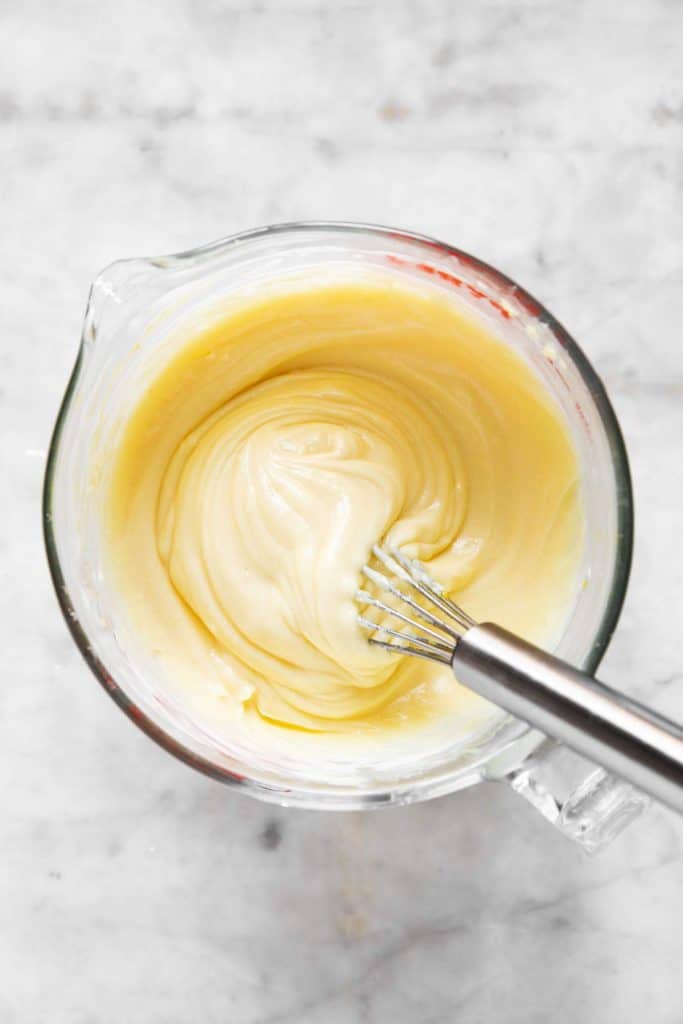
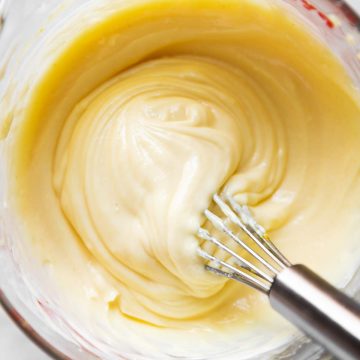
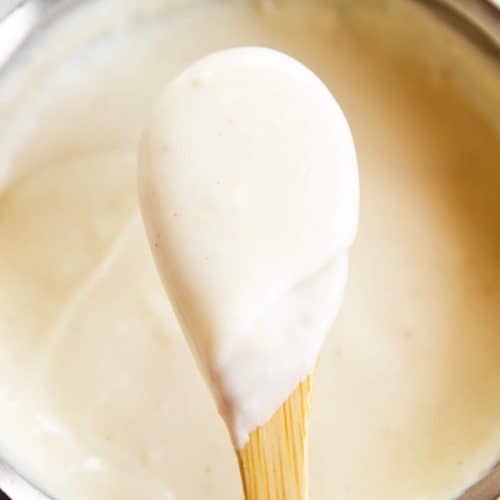
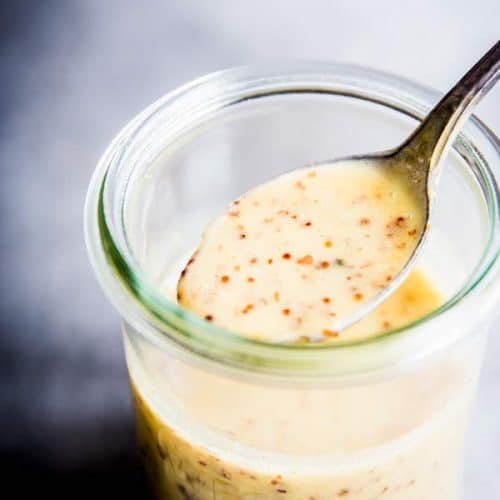
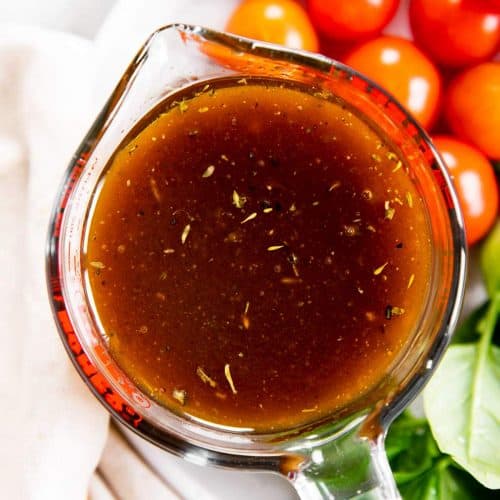
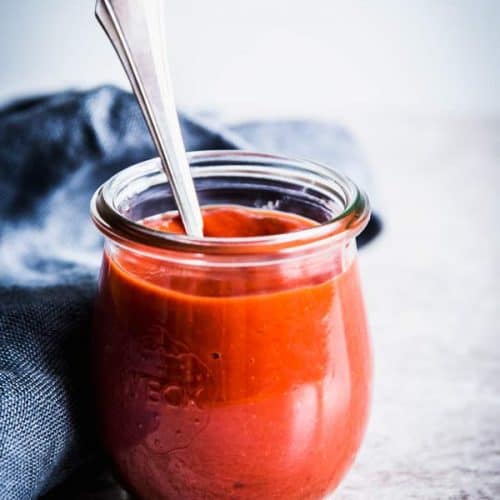

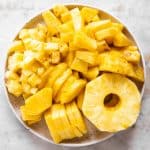
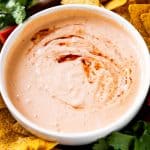
Grace says
Is there something that I can substitute for the mustard? I’m deathly allergic to it in every form, but I still want to make sure that it emulsifies correctly…. Especially since I’ve had three failed attempts (from other recipes) thus far.
Nora says
Hey Grace! Don’t worry, you can absolutely make mayo without mustard! To help emulsify the ingredients, you can substitute mustard with a small splash of vinegar or lemon juice (which is already in the recipe, but you can slightly increase the amount). Another trick is to add a tiny pinch of ground paprika or a dash of aquafaba (the liquid from a can of chickpeas) if you have it — it acts as a stabilizer.
The key is to add the oil super slowly while blending to ensure everything comes together smoothly. You’ve got this — fourth time’s the charm! 😊 Let me know how it turns out!
Jess says
Perfect Results! Thank you!
Jaimee says
I needed mayo for a recipe and didn’t have enough so I came across this recipe! Thank you so much! It came out perfect! My forearm is a little sore (jk). I used the pickle juice instead of vinegar and it’s delicious!! I followed the directions that were clearly laid out and it was easy! I don’t understand how the other reviews didn’t get it to work! I will definitely make this homemade Mayo recipe again!
Nora says
I’m so glad the mayo worked out well for you, Jaimee! You are now proof that this recipe does indeed work 😉
Jeri says
I followed exactly and whisked and whisked. It never thickened. Runny yellow oil.
Nora says
Did you read my response to the other comment saying the recipe doesn’t work? This is how you make mayo from scratch, there is no other way to do it if you want to whisk by hand. It’s just a recipe that’s tricky to get right, and mistakes can be made (adding too much oil at once, or breaking the emulsion by whisking for too long). It’s possible to salvage it though, like I said in my comment AND in the post. I hope you have better luck next time.
Dené Vogrin says
Great! Easy to follow recipe!
Sherri Dick says
Runny, never thickened!
Nora says
This is pretty much the chef’s standard recipe for homemade mayo, there’s really nothing you can do differently to make a true mayonnaise. You can find recipes using a blender, but they often fail due to overmixing and/or require a lot more egg yolks than necessary, yielding an off taste that’t too eggy.
For mayo to emulsify, the oil MUST be added slowly, as indicated in the recipe. This is the number one mistake people make when they unsuccessfully attempt to make mayonnaise – adding the oil too fast, or too much at a time. Think slow and thin tricklish stream, stop adding oil after each approximate tablespoon poured in and whisk until all of the oil is incorporated.
If you whisk for a long time and it’s liquid, you either added the oil too fast OR you over-whisked, breaking the emulsion. It should start to thicken pretty quickly once you start adding oil, and then continuously feel thicker as more and more oil is added. If you fail to incorporate each tablespoon of oil fully, allowing the emulsion to thicken before adding more oil, the recipe will NOT work.
There’s also this tip in the post for those inclined to actually read what they’re attempting to cook: “Don’t worry, you can fix your broken mayo. Either beat another egg yolk, or beat a teaspoon of mustard in a new bowl. Slowly add your broken mayo, beating it well. Once all of your mayo has been added, it should be re-emulsified.” This also works for those over-eagerly adding all of the oil too quickly, failing to slowly build an emulsion.
It’s not the easiest thing in the world to make mayo the old-fashioned way from scratch, but it’s also not rocket science if you follow the most important steps: Whisk the egg yolks well, add oil in a slow trickle, incorporate each tablespoon of oil well, stop whisking once all the oil has been added and the mayo is thick. Add another egg yolk in the way described above if your mayo fails to emulsify, or if it breaks due to over-whisking.